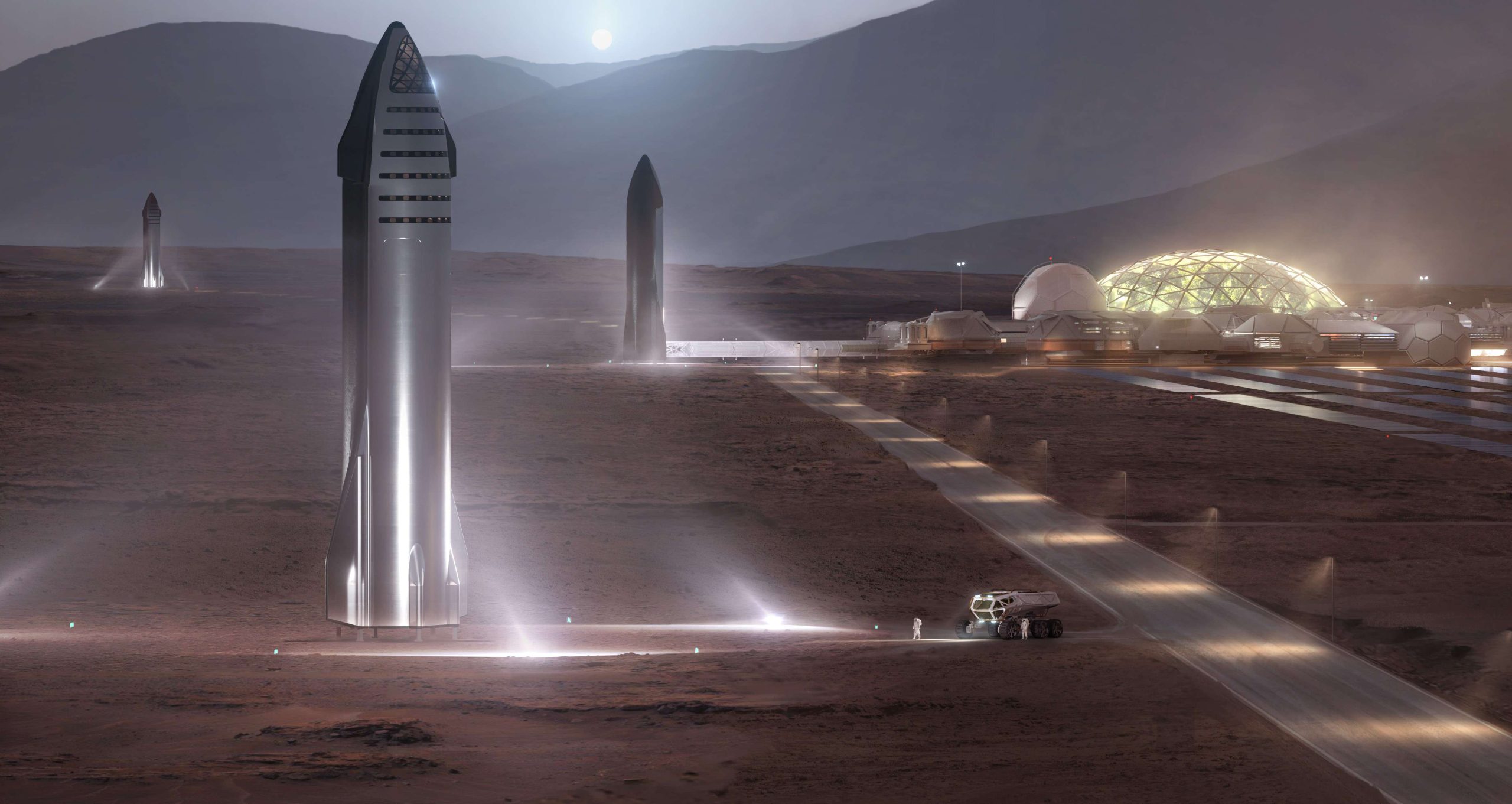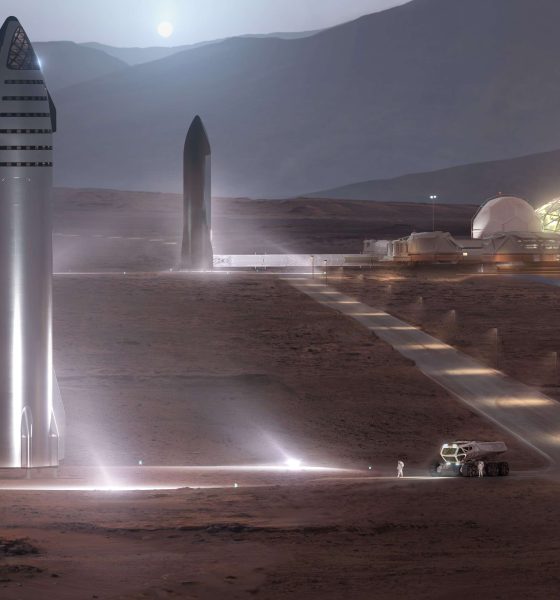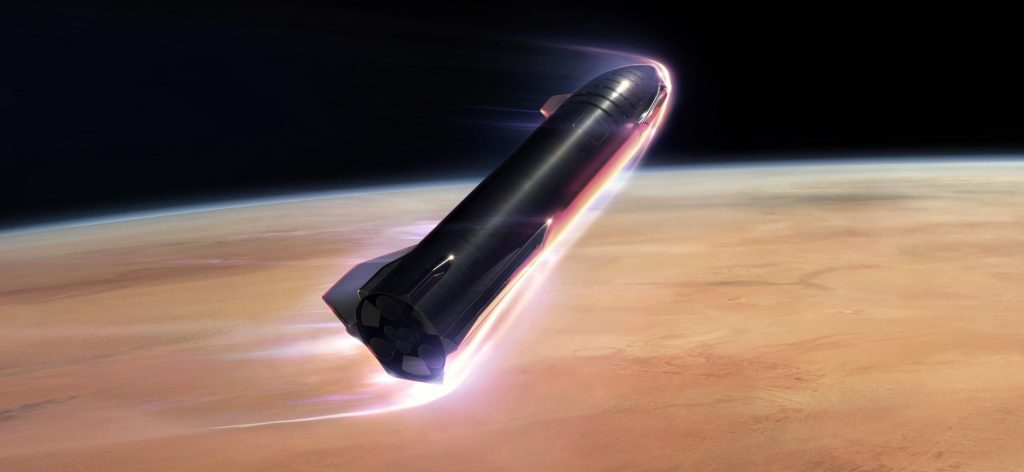

News
SpaceX could land Starship on Mars in 2024, says Elon Musk
Four years after Elon Musk revealed “aspirational” plans to launch Starships to Mars in 2022, the SpaceX CEO now believes that 2024 is a more accurate target.
For SpaceX, that two-year ‘delay’ is more impressive than anything given that the company practically restarted Starship development from scratch a year after Musk set the 2022 target. In late 2018, after more than two years of work developing a Starship (then BFR) built out of carbon fiber composites, the CEO revealed that the company was going to completely redesign the rocket to use steel for all major structures.
Two and a half years after that decision, SpaceX has built a vast Starship factory capable of building at least one ship per month, cumulatively fired dozens of full-scale Raptor engines for more than 30,000+ seconds, flown eight full-scale prototypes, and recovered the first full-size Starship in one piece after a high-altitude launch and bellyflop-style descent and landing.
It doesn’t come as a huge surprise that Starship probably wont be attempting any Mars launches in 2022. Had SpaceX not had to return to the drawing board in 2018, Musk may well have been able to achieve that 2022 goal, but wholly redesigning Starship with steel almost certainly delayed development by at least a year. For interplanetary launches, the most efficient trajectories – those that allow a rocket to maximize payload capacity – are only open for several weeks every ~25 months. That means that a rocket that’s one year behind a Mars launch window will still have to wait more than two years for the next launch opportunity.

In Starship’s case, even if SpaceX were ready for its first Mars cargo missions in 2023, it would need to wait until September or October 2024. That’s far from out of the question but three full years will arguably give SpaceX a good amount of time to both ensure that Starship is technically ready and reliable enough to land on Mars while also determining – and likely designing and building – the cargo those first Starships will carry.
SpaceX could also launch the first one or several Mars-bound Starships with an absolute minimum payload under the assumption that success will require several failures, in which case the company would have until 2026 to develop a system capable of finding and gathering Martian ice, processing it into cryogenic liquid oxygen and methane, and storing that propellant for months or even years. Without that complex system of in-situ resource utilization (ISRU), Starship will never be able to leave Mars, turning initial crewed missions into one-way trips.

In the meantime, while SpaceX has successfully proven that Starship’s exotic skydiver-style landing is viable on planets with atmospheres, orbital Starship flight tests will likely pose just as many challenges. Starship will have the largest heat shield of any spacecraft ever built, while that heat shield will also be the first non-ablative shield ever developed by SpaceX. Even if Starship aces reentries from low Earth orbit (LEO), reentries from geostationary, lunar, or Mars transfer orbits are all multiple times more stressful, requiring still more testing to ensure that its ceramic heat shield and steel hull can withstand interplanetary velocity reentries.
SpaceX will also have to develop unprecedented thermal management solutions to keep hundreds of tons of cryogenic liquid propellant at the right temperatures for weeks, months, or even years in orbit, deep space, and on the surfaces of other moons and planets. This is all to say that SpaceX has its work cut out for it as it approaches the dawn of orbital Starship flight tests and has to tackle a number of daunting technical challenges it might end up being the first to solve. But, as SpaceX always has, it will devour each problem piece by piece until Starship is exactly as capable and revolutionary as the company and its CEO have long promised – if a bit behind schedule.

Elon Musk
Elon Musk and Tesla AI Director share insights after empty driver seat Robotaxi rides
The executives’ unoccupied tests hint at the rapid progress of Tesla’s unsupervised Robotaxi efforts.

Tesla CEO Elon Musk and AI Director Ashok Elluswamy celebrated Christmas Eve by sharing personal experiences with Robotaxi vehicles that had no safety monitor or occupant in the driver’s seat. Musk described the system’s “perfect driving” around Austin, while Elluswamy posted video from the back seat, calling it “an amazing experience.”
The executives’ unoccupied tests hint at the rapid progress of Tesla’s unsupervised Robotaxi efforts.
Elon and Ashok’s firsthand Robotaxi insights
Prior to Musk and the Tesla AI Director’s posts, sightings of unmanned Teslas navigating public roads were widely shared on social media. One such vehicle was spotted in Austin, Texas, which Elon Musk acknowleged by stating that “Testing is underway with no occupants in the car.”
Based on his Christmas Eve post, Musk seemed to have tested an unmanned Tesla himself. “A Tesla with no safety monitor in the car and me sitting in the passenger seat took me all around Austin on Sunday with perfect driving,” Musk wrote in his post.
Elluswamy responded with a 2-minute video showing himself in the rear of an unmanned Tesla. The video featured the vehicle’s empty front seats, as well as its smooth handling through real-world traffic. He captioned his video with the words, “It’s an amazing experience!”
Towards Unsupervised operations
During an xAI Hackathon earlier this month, Elon Musk mentioned that Tesla owed be removing Safety Monitors from its Robotaxis in Austin in just three weeks. “Unsupervised is pretty much solved at this point. So there will be Tesla Robotaxis operating in Austin with no one in them. Not even anyone in the passenger seat in about three weeks,” he said. Musk echoed similar estimates at the 2025 Annual Shareholder Meeting and the Q3 2025 earnings call.
Considering the insights that were posted Musk and Elluswamy, it does appear that Tesla is working hard towards operating its Robotaxis with no safety monitors. This is quite impressive considering that the service was launched just earlier this year.
Elon Musk
Starlink passes 9 million active customers just weeks after hitting 8 million
The milestone highlights the accelerating growth of Starlink, which has now been adding over 20,000 new users per day.

SpaceX’s Starlink satellite internet service has continued its rapid global expansion, surpassing 9 million active customers just weeks after crossing the 8 million mark.
The milestone highlights the accelerating growth of Starlink, which has now been adding over 20,000 new users per day.
9 million customers
In a post on X, SpaceX stated that Starlink now serves over 9 million active users across 155 countries, territories, and markets. The company reached 8 million customers in early November, meaning it added roughly 1 million subscribers in under seven weeks, or about 21,275 new users on average per day.
“Starlink is connecting more than 9M active customers with high-speed internet across 155 countries, territories, and many other markets,” Starlink wrote in a post on its official X account. SpaceX President Gwynne Shotwell also celebrated the milestone on X. “A huge thank you to all of our customers and congrats to the Starlink team for such an incredible product,” she wrote.
That growth rate reflects both rising demand for broadband in underserved regions and Starlink’s expanding satellite constellation, which now includes more than 9,000 low-Earth-orbit satellites designed to deliver high-speed, low-latency internet worldwide.
Starlink’s momentum
Starlink’s momentum has been building up. SpaceX reported 4.6 million Starlink customers in December 2024, followed by 7 million by August 2025, and 8 million customers in November. Independent data also suggests Starlink usage is rising sharply, with Cloudflare reporting that global web traffic from Starlink users more than doubled in 2025, as noted in an Insider report.
Starlink’s momentum is increasingly tied to SpaceX’s broader financial outlook. Elon Musk has said the satellite network is “by far” the company’s largest revenue driver, and reports suggest SpaceX may be positioning itself for an initial public offering as soon as next year, with valuations estimated as high as $1.5 trillion. Musk has also suggested in the past that Starlink could have its own IPO in the future.
News
NVIDIA Director of Robotics: Tesla FSD v14 is the first AI to pass the “Physical Turing Test”
After testing FSD v14, Fan stated that his experience with FSD felt magical at first, but it soon started to feel like a routine.

NVIDIA Director of Robotics Jim Fan has praised Tesla’s Full Self-Driving (Supervised) v14 as the first AI to pass what he described as a “Physical Turing Test.”
After testing FSD v14, Fan stated that his experience with FSD felt magical at first, but it soon started to feel like a routine. And just like smartphones today, removing it now would “actively hurt.”
Jim Fan’s hands-on FSD v14 impressions
Fan, a leading researcher in embodied AI who is currently solving Physical AI at NVIDIA and spearheading the company’s Project GR00T initiative, noted that he actually was late to the Tesla game. He was, however, one of the first to try out FSD v14.
“I was very late to own a Tesla but among the earliest to try out FSD v14. It’s perhaps the first time I experience an AI that passes the Physical Turing Test: after a long day at work, you press a button, lay back, and couldn’t tell if a neural net or a human drove you home,” Fan wrote in a post on X.
Fan added: “Despite knowing exactly how robot learning works, I still find it magical watching the steering wheel turn by itself. First it feels surreal, next it becomes routine. Then, like the smartphone, taking it away actively hurts. This is how humanity gets rewired and glued to god-like technologies.”
The Physical Turing Test
The original Turing Test was conceived by Alan Turing in 1950, and it was aimed at determining if a machine could exhibit behavior that is equivalent to or indistinguishable from a human. By focusing on text-based conversations, the original Turing Test set a high bar for natural language processing and machine learning.
This test has been passed by today’s large language models. However, the capability to converse in a humanlike manner is a completely different challenge from performing real-world problem-solving or physical interactions. Thus, Fan introduced the Physical Turing Test, which challenges AI systems to demonstrate intelligence through physical actions.
Based on Fan’s comments, Tesla has demonstrated these intelligent physical actions with FSD v14. Elon Musk agreed with the NVIDIA executive, stating in a post on X that with FSD v14, “you can sense the sentience maturing.” Musk also praised Tesla AI, calling it the best “real-world AI” today.








